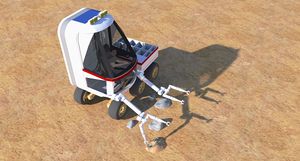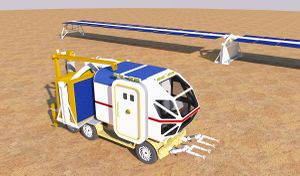Difference between revisions of "Mineralogical exploration"
| Line 3: | Line 3: | ||
More intensive exploration can be carried out in the future using, first, dedicated rovers and then human explorers. | More intensive exploration can be carried out in the future using, first, dedicated rovers and then human explorers. | ||
| − | + | Analysis could be carried out in-situ, but also in a well [[Research|equipped lab]] at a martian base | |
| + | [[File:Geologist.jpg|thumb|The geologist. A hypothetical rover with remote controlled manipulator arms, sampling tools and sample storage fro basic mineralogical exploration.]] | ||
| + | [[File:Quad.jpg|thumb|Geologist rover reconfigured with a moving/rotating cabin for human exploration.]] | ||
| − | == Mineralogical human exploration == | + | ==Mineralogical remote controlled rover== |
| + | A martian exploration mission will include some kind of mineralogical exploration rover. This vehicle will need to be able to extract samples and bring them back to a laboratory for analysis, or perform these analysis itself. Probably battery powered, the vehicle would need to be able to connect itself to a power supply to recharge the batteries. This would greatly increase the rapidity and capacities compared to existing rovers. | ||
| + | |||
| + | [[File:Drill rig.jpg|thumb|General purpose rover configured with a drill rig and extensive exploration capabilities. The rover can carry a large photovoltaic array to supply it with power and extend the range to the limit of the life support systems aboard.]] | ||
| + | |||
| + | ==Mineralogical human exploration== | ||
| + | For fast exploration, a human presence will be vastly superior to robotic exploration. Decisions can be made on the spot and manipulators can be controlled directly. | ||
Revision as of 09:25, 31 July 2019
Mineralogical exploration is already underway on Mars using the various rovers sent by the US and remote sensing from orbital probes.
More intensive exploration can be carried out in the future using, first, dedicated rovers and then human explorers.
Analysis could be carried out in-situ, but also in a well equipped lab at a martian base
Mineralogical remote controlled rover
A martian exploration mission will include some kind of mineralogical exploration rover. This vehicle will need to be able to extract samples and bring them back to a laboratory for analysis, or perform these analysis itself. Probably battery powered, the vehicle would need to be able to connect itself to a power supply to recharge the batteries. This would greatly increase the rapidity and capacities compared to existing rovers.
Mineralogical human exploration
For fast exploration, a human presence will be vastly superior to robotic exploration. Decisions can be made on the spot and manipulators can be controlled directly.









